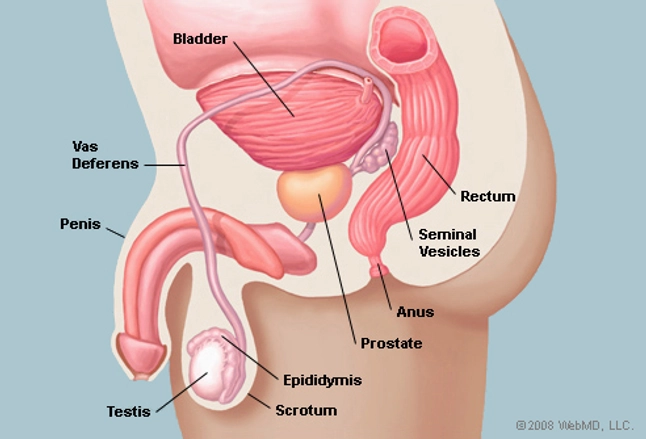
Side View of the Prostate
The prostate is a walnut-sized gland located between the bladder and the penis. The prostate is just in front of the rectum. The urethra runs through the center of the prostate, from the bladder to the penis, letting urine flow out of the body.
CONTINUE READING BELOW
The prostate secretes fluid that nourishes and protects sperm. During ejaculation, the prostate squeezes this fluid into the urethra, and it’s expelled with sperm as semen.
The vasa deferentia (singular: vas deferens) bring sperm from the testes to the seminal vesicles. The seminal vesicles contribute fluid to semen during ejaculation.
Prostate Conditions
- Prostatitis: Inflammation of the prostate, sometimes caused by infection. It is typically treated with antibiotics.
- Enlarged prostate: Called benign prostatic hypertrophy or BPH, prostate growth affects virtually all men over 50. Symptoms of difficult urination tend to increase with age. Medicines or surgery can treat BPH.
- Prostate cancer: It’s the most common form of cancer in men (besides skin cancer), but only one in 41 men die from prostate cancer. Surgery, radiation, hormone therapy, and chemotherapy can be used to treat prostate cancer. Some men choose to delay treatment, which is called watchful waiting.
Prostate Tests
- Digital rectal examination (DRE): A doctor inserts a lubricated, gloved finger into the rectum and feels the prostate. A DRE can sometimes detect an enlarged prostate, lumps or nodules of prostate cancer, or tenderness from prostatitis.
- Prostate-specific antigen (PSA): The prostate makes a protein called PSA, which can be measured by a blood test. If PSA is high, prostate cancer is more likely, but an enlarged prostate can also cause a high PSA. Recommndations about whether or not a man should be screened and at what age differ. Talk with your doctor about whether you need testing and the potential benefits and risks.
- Prostate ultrasound (transrectal ultrasound): An ultrasound probe is inserted into the rectum, bringing it close to the prostate. Ultrasound is often done with a biopsy to test for prostate cancer.
- Prostate biopsy: A needle is inserted into the prostate to take tissue out to check for prostate cancer. This is usually done through the rectum.
Prostate Treatments
Enlarged Prostate Treatment
- Alpha-blockers: Alpha-blockers relax the muscles around the urethra in men with symptoms from an enlarged prostate. Urine then flows more freely.
- 5-alpha-reductase inhibitors: These medications reduce the level of a certain form of testosterone (DHT). The prostate shrinks when less DHT is present, improving urine flow.
- Surgery for an enlarged prostate: Usually, medications resolve symptoms of an enlarged prostate, but some men require surgery to improve symptoms and prevent complications.
Prostate Cancer Treatment
- Prostatectomy: Surgery for prostate cancer, called a prostatectomy, removes the prostate with the goal of removing all the cancer.
- Radiation therapy: Radiation kills prostate cancer cells while minimizing damage to healthy cells.
- Radioactive seed implants: Instead of radiation pointed at the prostate from outside the body, radioactive seeds can be implanted into the prostate to kill cancer cells.
- Cryotherapy: Cryotherapy involves killing prostate cancer cells by freezing them.
- Hormone therapy: Prostate cancer cells grow in response to hormones. Hormone therapy helps block that effect.
- Chemotherapy: When prostate cancer is advanced, chemotherapy may help reduce the cancer’s spread.
- Watchful waiting: Since prostate cancer is often slow growing, some older men and their doctors hold off on treatment and wait to see if the cancer appears to be growing.
- Clinical trials: Through prostate cancer clinical trials, researchers test the effects of new medications on a group of volunteers with prostate cancer.
Prostatitis Treatment
- Acute and chronic prostatitis: Depending on the type of prostatitis, treatment includes antibiotics, other medications, and/or surgery.
What Is the Prostate? What's Normal?
Many men aren't sure what their prostate is, what it does, or when to call a doctor if they think they might have a problem. So, information is the best tool you have in dealing with this aspect of men’s health.What Does My Prostate Do?
It is a small gland that is part of the male reproductive system. It's supposed to be about the shape and size of a walnut.It rests below your bladder and in front of your rectum. It surrounds part of the urethra, the tube in your penis that carries pee from your bladder.The prostate helps make some of the fluid in semen, which carries sperm from your testicles when you ejaculate.This Gland Can Grow
As you age, your prostate can become larger. It’s a normal part of aging for most men.CONTINUE READING BELOW
By the time you reach age 40, your prostate might have gone from the size of a walnut to the size of an apricot. By the time you reach 60, it might be the size of a lemon.Because it surrounds part of the urethra, the enlarged prostate can squeeze that tube. This causes problems when you try to pee. Typically, you won’t see these problems until you’re 50 or older, but they can start earlier.You might hear a doctor or nurse call this condition benign prostatic hyperplasia, or BPH for short. It is not cancerous Who Might Get an Enlarged Prostate?BPH is common and cannot be prevented. Age and a family history of BPH are two things that increase the chances you might get it. A few stats on that:- Some 8 out of every 10 men eventually develop an enlarged prostate.
- About 90% of men over the age of 85 will have BPH.
- About 30% of men will find their symptoms bothersome








No comments:
Post a Comment